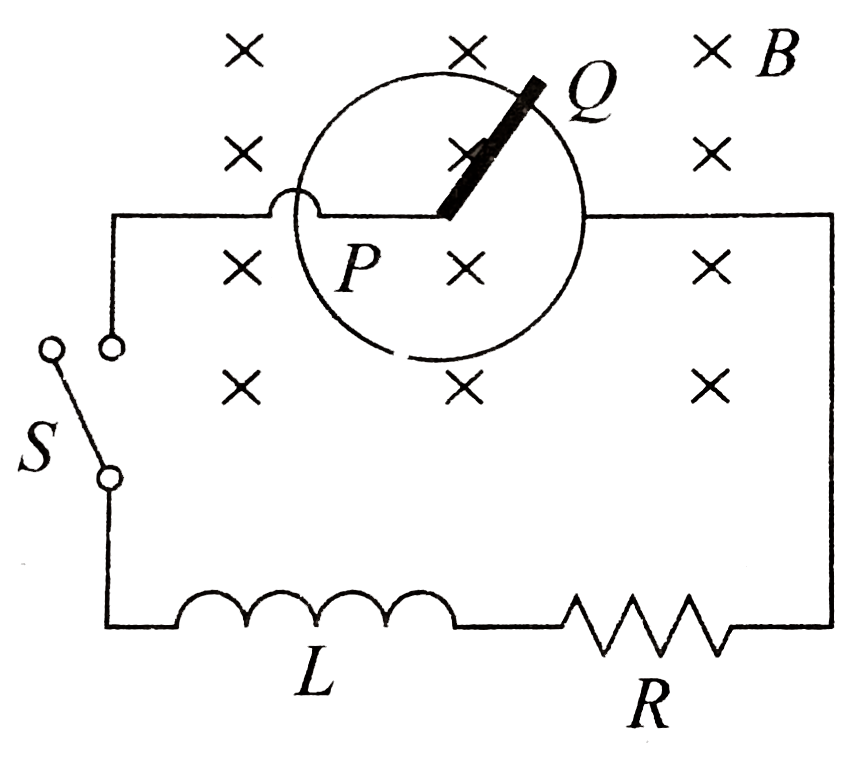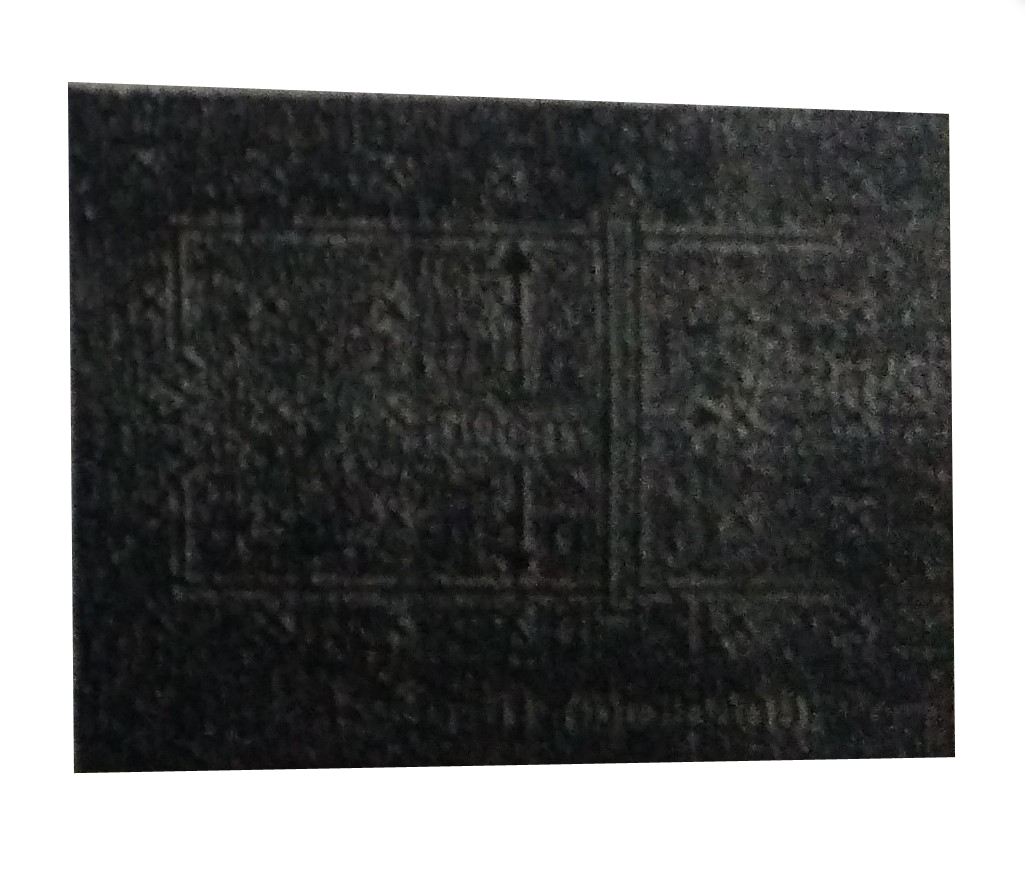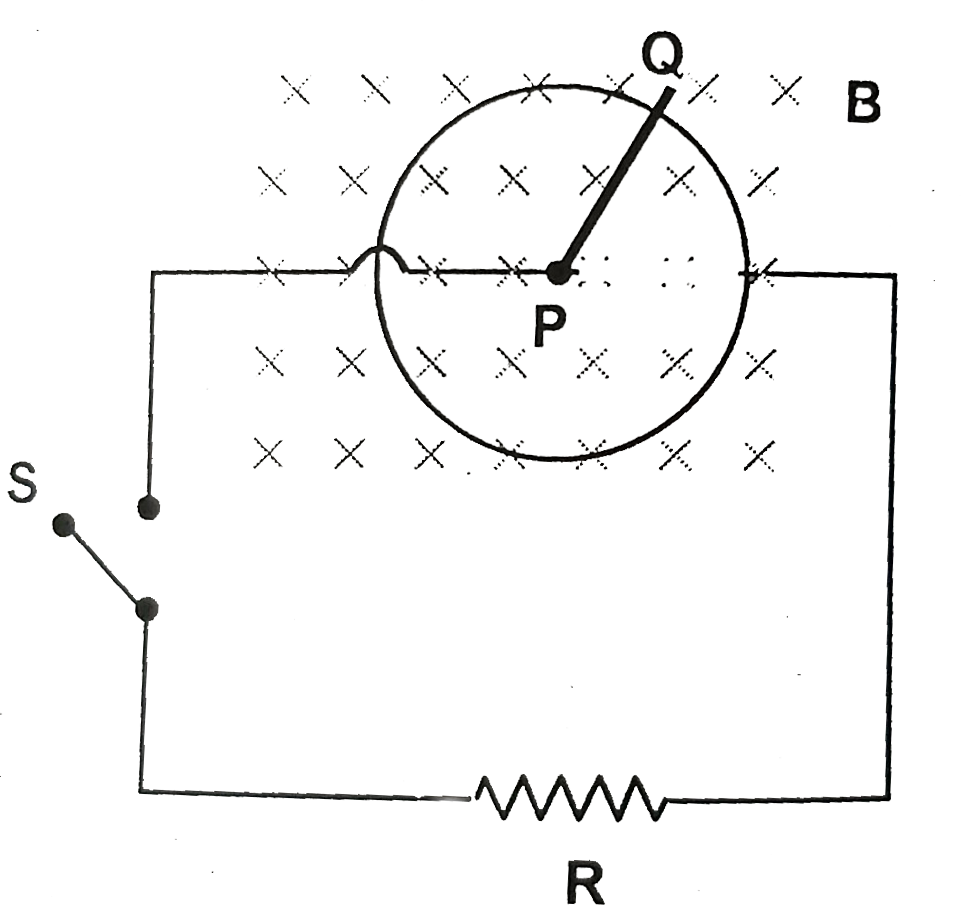The diagram shows a circuit having a coil of resistance and inductance L connected to a conducting rod PQ which can slide on a perfectly conducting circular ring of radius 10 cm with its centre at 'P' Assume that friction & gravity are absent and a constant uniform magnetic field of 5 T exists as shown in figure. At the circuit is switched on and simultaneously a time varying external torque is applied on the rod so that it rotates about P with a constant angular velocity 40 rad//s Find magnitude of this torque (in mu Nm) when current reaches half of its maximum value. Neglect the self inductance of the loop formed by the circuit.

The correct Answer is:
Induced EMF
At any time t
Solving for I, we get
Torque about the hinge P is
Max. value occur at and half of this is equal to
:. Torque at this instant
Topper's Solved these Questions
- BOOK - BANSALCHAPTER - MASTER PRACTICE PROBLEMEXERCISE - Additional topic70videos
MASTER PRACTICE PROBLEM
- BOOK - BANSALCHAPTER - MASTER PRACTICE PROBLEMEXERCISE - Multiple objective131videos
MASTER PRACTICE PROBLEM
- BOOK - BANSALCHAPTER - FLUID MECHANICSEXERCISE - PYQS AIEEE10videos
FLUID MECHANICS
- BOOK - BANSALCHAPTER - SEMICONDUCTORSEXERCISE - CBSE Question32videos
SEMICONDUCTORS
Similar Questions
The diagram shows a circuit having a coil of resistance R=2.5(Ω) and inductance L connected to a conducting rod PQ which can slide on perfectly conducting circular ring of radius 10 cm with its centre at 'P'. Assume that friction and gravity are absent and a constant uniform magnetic field of 5 T exist as shown in Fig.

At t = 0, the circuit is switched on and simultaneously a time varying external torque is applied on the rod so that it rotates about P with a constant angular velocity 40rad/s. Find magnitude of this torque (in milli Nm) when current reaches half of its maximum value. Neglect the self-inductance of the loop formed by the circuit.View SolutionFigure shows a circuit having a coil of resistance R=2.5Ω and inductance L connected to a conducting rod of radius 10cm with its center at P.

Assume that friction and gravity are absent and a constant uniform magnatic field of 5T exists as shown in figure. At t=0, the circuit is switched on and simultaneously a time-varying external torque is applied on the rod so that it rotates about P with a constant angular velocity 40rads−1. Find the magnitude of this torque (in mNm) when current reaches half of its maximum value. Neglect the self inductance of the loop formed by the circuit.View Solution
Knowledge Check
- Question 1 - Select One
A metallic rod completes its circuit as shown in the figure. The circuit is normal to a magnetic field of B=0.15 tesla. If the resistances of the rod is 3Ω the force required to move the rod with a constant velocity of 2m/sec is-
 A3.75×10−3NB3.75×10−2NC3.75×102ND3.75×10−4N
A3.75×10−3NB3.75×10−2NC3.75×102ND3.75×10−4N - Question 2 - Select One
A coil of 10 H inductance and 5Ω resistance is connected to 5 volt battery in series . The current in ampere in circuit 2 seconds after switched is on :-
Ae−1B(1−e−1)C(1−e)De - Question 3 - Select One
AB and CD are fixed conducting smooth rails placed in a vertical palne and joined by a constant current source at its upper end. PQ is a conducting rod which is free to slide on the rails. A horizontal uniform magnetic field exists in space as shwn in figure. If the rod PQ is released from rest then,
 Athe rod PQ will move downward with constant accelerationBthe rod PQ will move upward with constant accelerationCthe rod will remain at restDany of the above
Athe rod PQ will move downward with constant accelerationBthe rod PQ will move upward with constant accelerationCthe rod will remain at restDany of the above
The circuit shows a resistance R=0.01Ω and inductance L=3mH connected to a conducting rod PQ of length I=2m which can side on a perfectly conducting circular arc of radius I with its centre at P. Assume that friction & gravity are absent and a constant uniform magnetic field B=0.1T exists as shown in the figure. At t=0 the circuit is switched on and simultaneously an external torque is applied on the rod so that it rotates about P with a constant angular velocity ω=2 rad/sec. Find the magnitude of this torque (in N−m) at t=0 (0.3 In2) second
 View Solution
View SolutionThe circuit shows a resistance, R=0.01Ω and inductance L=3mH connected to a conducting rod PQ of length l=wm which can slide on a perfectly conducting circular arc of radius l with its center at P. Assume that friction and gravity are absent and a constant uniform magnetic field b=0.1T exists as shown in the figure. At t=0, the circuit is seitched on a simultaneously an external torque is applied on the rod so that it rotates about P with a constant angular velocity ω2rad/sec. Find the magnitude of this torque (inN-m) at t=(0.3In 2) second.
 View Solution
View SolutionThe circuit shows a resistance, R=0.01Ω and inductance L=3mH connected toa conducting rod PQ of length l=wm which can slide on a perfectly conducting circular arc of radius l with its center at P. Assume that friction and gravity are absent and a constant uniform magnetic field b=0.1T exists as shown in the figure. At t=0, the circuitt ois seitched on a simultaneously an external torque is applied on the rod so that it rotates about P with a constant angular velocity ω2rad/sec. Find the magnitude of this torque (inN-m) at t=(0.3In 2) second.
 View Solution
View SolutionA resitance R=1kΩ connected to a conducting rod PQ that can slide on a conducting circular ring of radius 2m with center at P. A constant uniform magnetic field 10 Tesla exist as shown in figure. At t=0, switch 'S' is closed and simulaneously an external torque is applied on the rod so that it rotates with constant angular velocity 20rad/sec. The magnitude of power delivered by external is 20K Watt. Find the value of K. (Neglect the gravity, friction and self inductance of circular loop)
 View Solution
View SolutionA conducting ring of mass 2 kg and radius 0.5 m is placed on a smooth horizontal plane. The ring carries a current 4A . A horizontal magnetic field B = 10T is switched on at time t = 0 as shown in figure. The initial angular acceleration of the ring will be:
 View Solution
View Solution

